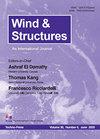侧风作用下铁路车辆倾覆评定
IF 1.9
4区 工程技术
Q3 CONSTRUCTION & BUILDING TECHNOLOGY
引用次数: 2
摘要
大风中的倾覆问题对铁路车辆至关重要,多年来引起了人们的极大关注。为了解决这些问题,本文引入了一种动态可靠性方法来评估车辆在侧风中的倾覆风险。从气动模型出发,推导了一个考虑完全湍流场效应的非定常侧风力预测公式。利用伪激励方法(PEM),通过建立的车辆模型计算车辆响应的功率谱,最后将相应的结果用于评估车辆的概率倾覆动态可靠性分析。通过计算发现,随时间变化的失效概率曲线与车速、风速和侧风方向有关,与以往研究中的传统特征风曲线相比,不同失效概率下的概率特征风曲线在评估倾覆风险方面更有用、更合理。此外,还建立了考虑侧风方向影响的概率特征风面(PCWS),表明车辆在垂直侧风方向的情况下最容易受到影响。本文章由计算机程序翻译,如有差异,请以英文原文为准。
Overturning assessment of railway vehicles under cross winds
The overturning issues in a strong wind are extremely critical to the railway vehicles, which have attracted a great deal of attention over the years. To address such problems, this paper introduces a dynamic reliability approach to evaluate the overturning risk of vehicles in crosswinds. Starting from the aerodynamic model, a novel prediction formula of unsteady crosswind forces with a consideration of the complete turbulent field effect is derived. Using the pseudo-excitation method (PEM), the power spectrum of vehicle responses is then calculated by the established vehicle model, and finally the corresponding results are used to assess the probabilistic overturning of vehicles in terms of the dynamic reliability analysis. It is found from the calculations that the time-dependent failure probability curves are related to the vehicle speed, wind speed, and crosswind direction, and the probabilistic characteristic wind curves (PCWCs) at different failure probabilities are more useful and reasonable for evaluating the overturning risk in comparison with the traditional characteristic wind curves (CWCs) in previous investigations. Furthermore, the probabilistic characteristic wind surface (PCWS) that considers the effect of crosswind direction, is developed, and it reveals that the vehicle is most vulnerable at a condition of perpendicular crosswind direction.
求助全文
通过发布文献求助,成功后即可免费获取论文全文。
去求助
来源期刊

Wind and Structures
工程技术-工程:土木
CiteScore
2.70
自引率
18.80%
发文量
0
审稿时长
>12 weeks
期刊介绍:
The WIND AND STRUCTURES, An International Journal, aims at: - Major publication channel for research in the general area of wind and structural engineering, - Wider distribution at more affordable subscription rates; - Faster reviewing and publication for manuscripts submitted.
The main theme of the Journal is the wind effects on structures. Areas covered by the journal include:
Wind loads and structural response,
Bluff-body aerodynamics,
Computational method,
Wind tunnel modeling,
Local wind environment,
Codes and regulations,
Wind effects on large scale structures.
 求助内容:
求助内容: 应助结果提醒方式:
应助结果提醒方式:


